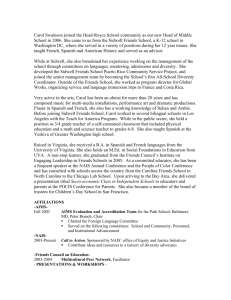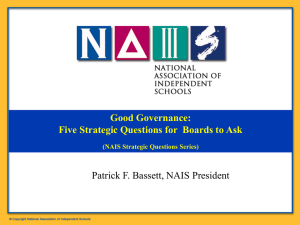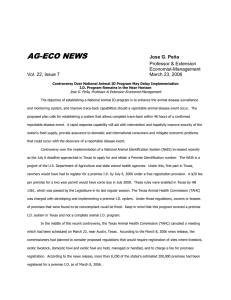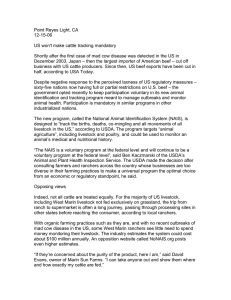Animal ID: Costs and Benefits. Gary Brester and Vince Smith FPCC
advertisement
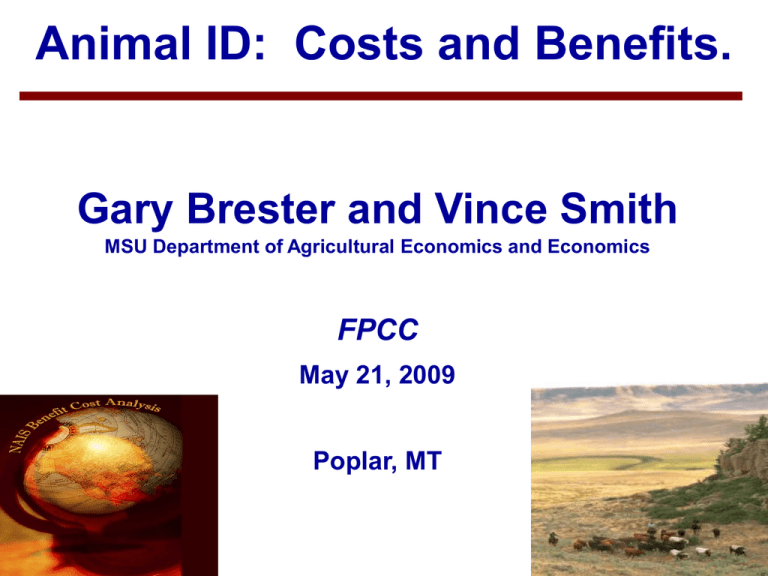
Animal ID: Costs and Benefits. Gary Brester and Vince Smith MSU Department of Agricultural Economics and Economics FPCC May 21, 2009 Poplar, MT 1 OUTLINE 1. Animal ID Issues 2. Animal ID Systems 3. NAIS Project Objectives 4. Research Strategy 5. Findings 6. Questions 2 OUTLINE 1. Animal ID Issues 2. Animal ID Systems 3. NAIS Project Objectives 4. Research Strategy 5. Findings 6. Questions 3 Animal ID Issues 1. What are the benefits of a National Animal Identification System (NAIS)? 2. What technology and data management system should be utilized? 3. What are the costs of an NAIS? 4. Does an AIS need to be a national AIS 5. If the key benefit of an NAIS is improved access to export markets, what NAIS technologies and data management systems 4 are acceptable to those markets? OUTLINE 1. Animal ID Issues 2. Animal ID Systems 3. NAIS Project Objectives 4. Research Strategy 5. Findings 6. Questions 5 Animal ID Systems 1. Premises Registration: a first step that provides little information other than who is a producer. 2. Bookend System: identifies the animal (or, in the case of hogs, poultry and sheep, a group or lot of animals) at place of birth and place of slaughter. Estimated cost per cow for a ranch in the U.S. is $3.92. (Dairy cows are less expensive) 3. Full Tracing System: records places of birth and slaughter and also recording animal movements through their lifetime as they change ownership (and, in Europe, place). Estimated cost per cow in the U.S. is $4.22. 6 ID System (estimated cost per animal) Animal\Stage of production Bookend Full Tracing Dairy Cow (on the farm) $2.47 $3.43 Beef Cow (on the ranch) $3.92 $4.22 Backgrounding $0.23 $0.71 Feedlot $0.20 $0.51 Auction Markets $0.00 $0.23 Beef Packers $0.10 $0.10 7 OUTLINE 1. Animal ID Issues 2. Animal ID Systems 3. NAIS Project Objectives 4. Research Strategy 5. Findings 6. Questions 8 NAIS Project Objectives 1. Comprehensive economic assessment of the benefits and costs of the National Animal Identification System (NAIS) 2. Determine benefits/costs of NAIS by species 3. Determine benefits/costs of NAIS by sector and scale 4. Determine societal benefits of NAIS among producers, intermediaries, consumers, and government 9 OUTLINE 1. Animal ID Issues 2. Animal ID Systems 3. NAIS Project Objectives 4. Research Strategy 5. Findings 6. Questions 10 NAIS Research Strategy 1. Determine benefits and costs of NAIS by adoption scenarios a. Premise registration b. “Bookend” identification c. Full traceability 2. ID at birth and record at animal termination Animal/group movement Varying adoption rates of each a. 30%, 50%, 70%, 90% 11 NAIS Research Process 1. 2. Literature review a. Synthesized more than 250 benefit/cost publications Industry stakeholder meetings a. More than 50 meetings b. Over 100 stakeholders c. Elicited a variety of information Anticipated costs Perceived benefits Challenges 12 Opportunities NAIS Research Process d. Partial list of groups included in the stakeholder interviews National Cattlemen’s Beef Assoc. Livestock Marketing Assoc. U.S. Meat Export Federation Superior Lamb National Livestock Producers R-CALF U.S.A Pro Rodeo Cowboys Assoc. 13 NAIS Research Process 3. Direct cost estimation a. Developed methodologies to measure direct industry costs 4. Evaluate governmental costs and benefits 5. Estimate the benefits that would have to occur to offset the direct costs 6. Allocate benefits across a. Species b. Consumers c. Producers 14 Schematic of Research Process - Literature - Expert opinions - Industry meetings - Private and public data - Statistical analyses 15 Schematic of Research Process - Literature - Expert opinions - Industry meetings - Private and public data - Statistical analyses Direct Cost Estimates 16 Schematic of Research Process - Literature - Expert opinions - Industry meetings - Private and public data - Statistical analyses Direct Cost Estimates Economic Model Sr " Price Sr Pr " Pr Sf " B Sf Pf " Pf α1 α0 0 Dr Df A D f' Q2 Q0 Quantity 17 Schematic of Research Process - Literature - Expert opinions - Industry meetings - Private and public data - Statistical analyses Economic Model Direct Cost Estimates Net Benefit/Costs: Sr " Price - Producers Sr Pr " Pr B Sf Pf " Pf α1 α0 0 - Wholesale Sf " Dr - Retail Df A D f' Q2 Q0 Quantity 18 - Consumers Direct Cost Estimates 1. 2. Estimate annual costs of NAIS a. Bovine (individual RFID tags) b. Porcine (group hogs; tag culls) c. Poultry (group) d. Ovine (group lambs; tag culls) e. Equine (individual microchip) Estimate costs across a. Production sectors b. By size of operation 19 c. By various adoption rates Direct Costs: Cattle Sectors 1. 2. Cattle sectors considered a. Breeding herd operations b. Backgrounding operations c. Finishing operations d. Auction markets e. Slaughtering operations Estimate costs across a. Identification system b. By size of operation c. By various adoption rates 20 Direct Costs: Cattle Sectors 3. Cost categories a. Tagging-related costs Tags and applicators Labor/chute costs Shrink Injury (human and animal) b. Tag reading costs Capital investments Labor/chute Shrink/injury c. Premise registration Management time 21 Direct Costs: Cattle Sectors 4. Direct cost depreciation and interest a. Capital equipment with more than one year of useful life b. Annual interest costs for portion of year that costs are incurred c. Annual premise registration costs include initial cost and 3-year renewal costs d. Assumed interest rate of 7.75% 22 Direct Costs: Cattle Sectors 5. Direct cost RFID components a. Five categories Electronic reader Data accumulator Software Data storage Other (labor, internet, etc.) b. Custom reading charges based on brand inspection fees c. Assumed that custom reading would be used if it were less 23 expensive than owning equipment Costs/Productivity/Interactions 1. Use an economic model of the meat industry to allocate costs, changes in productivity, and interactions across sectors a. Four species Beef Pork Lamb Poultry b. Consider multiple sectors for each species 24 c. Include import and export sectors Inclusion Of Benefits 1. Multiple benefits could occur a. Better animal health b. Export market access c. Facilitate MCOOL requirements d. Increase product branding e. Improve food safety assurance f. g. h. i. Faster response to disease issues Reduce costs of disease mitigation Improve cattle production efficiency 25 Ownership verification Inclusion Of Benefits 2. Difficult to quantify all of these a. The major issues seem to center on export markets and domestic demand 3. So, we asked two questions: a. How much improvement in export access would we need to completely offset these additional costs? b. How much improvement in domestic demand would we need to completely offset these costs? 4. We used our economic model of the meat industry to answer these questions 26 OUTLINE 1. Animal ID Issues 2. Animal ID Systems 3. NAIS Project Objectives 4. Research Strategy 5. Findings 6. Questions 27 Cattle/Beef Industry Drives The Results 1. Cattle/Beef sector has the largest costs 2. The Cattle/Beef industry has the most to gain in terms of market access 3. Increased export/domestic demand raises beef/cattle prices a. Pork and poultry are beef substitutes Higher beef prices increases the demand for both Pork and poultry prices rise enough to offset their “relatively” small NAIS costs quickly 28 Cattle/Beef Industry Costs 1. Full Tracing/90% Adoption a. Cow/Calf: $4.91/head b. Background: $0.70/head c. Feedlot: $0.51/head d. Auctions: $0.23/head e. Packers: $0.10/head 2. Total beef industry: $6.46/head 29 Export Market Access Change in Beef Export Demand That Offsets Producer Costs Export Demand Increase 40% 34.9% 35% 30% 23.7% 25% 20% 14.9% 15% 10% 8.0% 5% 0% 30% 50% 70% 90% NAIS Full Traceability Adoption Rate 30 Domestic Demand Change in Domestic Beef Demand That Offsets Producer Costs Domestic Demand Increase 1% 0.98% 1% 1% 0.69% 1% 0% 0.44% 0.25% 0% 0% 30% 50% 70% 90% NAIS Full Traceability Adoption Rate 31 Summary 1. Comprehensive NAIS benefit/cost study a. Stakeholders b. Detail cost breakdowns c. Productivity impacts d. Governmental costs 2. Benefits are difficult to quantify a. Estimate export/domestic demand increases that offset producer costs 3. If we re-acquire export markets to pre-2003 levels because of NAIS a. Producer economic well-being will be improved 32 Summary 4. APHIS has released the NAIS study a. 500 page document b. APHIS produced media products 5. http://animalid.aphis.usda.gov/nais/ naislibrary/factsheets.shtml a. An overview of the project b. Targeted Fact Sheets c. A dozen brochures d. Documents that are “hot linked” to the major report 33 QUESTIONS? Picture Courtesy of Clint Peck 34

